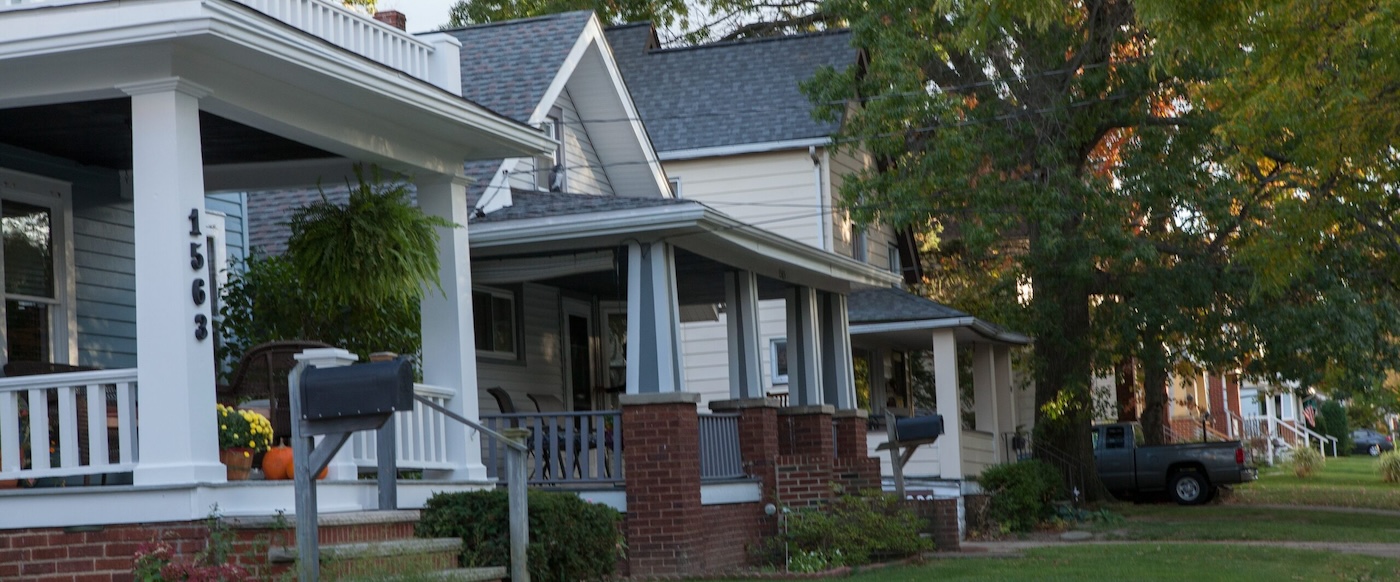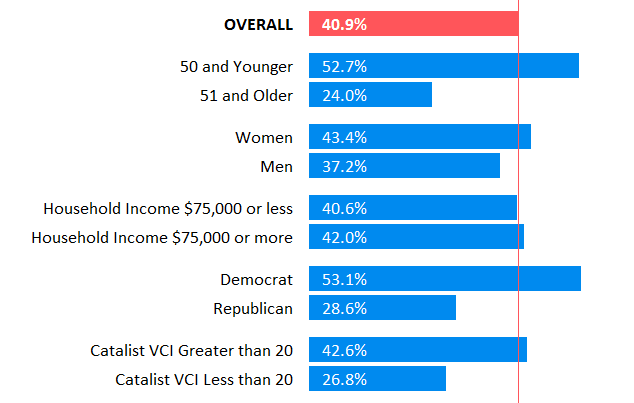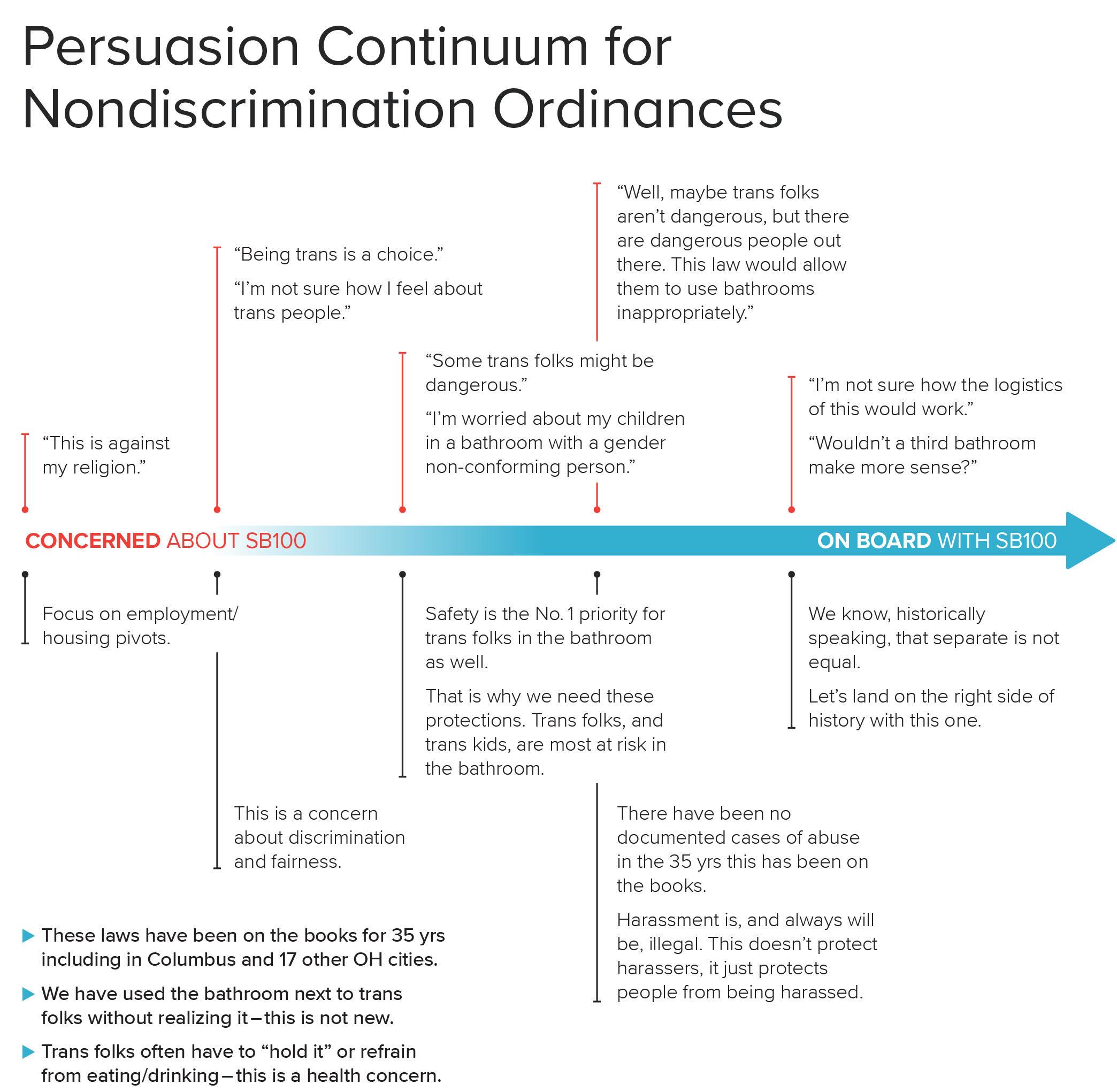Chip in Now to Stand Up for Working People
Working people need a voice more than ever and Working America is making that happen.
Working people need a voice more than ever and Working America is making that happen.


07/21/2017
OVERVIEW
During the first two weeks in May, Working America canvassers held in-depth conversations with 784 working- and middle-class voters in central Ohio. Our team explored attitudes about SB 100, the state legislative proposal to outlaw discrimination against LGBTQ individuals in employment, housing and public accommodations. This includes access to the public bathroom that aligns with a person’s gender identity rather than the sex they were assigned at birth.
While we anticipated support for policies protecting LGBTQ individuals from employment and housing discrimination, we didn’t know how working- and middle-class voters in central Ohio would react to discussions about bathroom access for gender-nonconforming individuals. We set out to learn how these voters would respond to conversations about the proposal that explicitly raised bathroom access.
We sought to understand:
We found considerable support for SB 100 among voters younger than 50, with 53 percent willing to sign a petition in support of the statewide measure. Many voters started out supportive of the initiative but paused at the point at which we brought up bathroom access, even those who identified as being supportive of gays and lesbians and who voiced support for housing and employment protections. The project revealed that voters have little exposure to transgender individuals, have not thought about their rights as citizens, and are initially cautious, even fearful, on the subject of bathroom access. In several cases, this led to visible discomfort or voters having a hard time vocalizing their rationale for discrimination.
By explicitly raising the issue of bathroom access as part of the bill, canvassers set a high bar to persuade voters to support SB 100. Despite negative stereotypes of transgender people and a general lack of information among voters, canvassers were able to establish trust, hold a fruitful conversation with most voters and generate significant support across demographics. Overall, 41 percent of the people we spoke with signed the petition in support of the statewide measure.
Of the voters we spoke with, the vast majority (74 percent) lived in households making $75,000 a year or less and 56 percent were female. Most were white (89 percent), 9 percent were African-American and the remaining 2 percent were Latinx, Asian or unknown.
Based on our conversations, we found through this project that progressives have an opening to define what’s at stake in nondiscrimination laws and move undecided or confused voters to being supportive.
KEY FINDINGS
AGE: Age was the biggest predictor of willingness to sign the petition in support of SB 100. Voters younger than 50 generally were supportive of nondiscrimination legislation, with 53 percent willing to sign. In contrast, only 24 percent of voters older than 50 signed it.
Jay, 32: “I don’t know what the big fuss is. What are people worried about? Are they worried about people peeking over the stalls at each other?”
PARTY: While we did see a partisan split in support, with 53 percent of registered Democrats signing compared with 29 percent of registered Republicans, we were able to mobilize a portion of even the staunchest conservatives. Indeed, for most voters this was not a partisan issue. (Ohio does not require party registration. To get a more precise indicator of the partisan leanings of voters, we used Catalist Vote Choice Index [VCI] score, which assigns a value of 0-100 to each voter, with higher scores signaling Democratic support and lower scores signaling GOP support.)
Laura, 44, is a Republican who initially expressed opposition to transgender bathroom choice: “I have a granddaughter, so I’m a little worried about men in the women’s room.” The canvasser said harassment in bathrooms will remain illegal if the law is enacted, and without it LGBTQ people risk health problems if they’re afraid to use public restrooms. Although she didn’t sign the petition, it was clear that her attitude had changed during the conversation. “My religion tells me no … But, hey, everyone has the right to pee. Everyone has their own sins to deal with. I don’t think Jesus was against peeing.”
Lisa, 60, voted for Trump, and while supportive of the housing and employment aspects of the law, on the bathroom subject, she said, “That part confuses me.” The canvasser explained that the law is already on the books in Columbus and nearby cities and, “We have probably all used the bathroom next to a transgender person without realizing it — this just means … that [everyone] can use the bathroom safely.” Lisa signed the petition saying, “Sometimes you just gotta go!”
Similarly, even among people who did not sign the petition, canvassers rated more than half the people they spoke with as supportive of transgender rights. This indicates that something other than opposition to SB 100 may have discouraged some people from signing. Canvassers did hear some reluctance among older voters to signing online or providing email addresses, but more research would be required to determine any cause and effect.
GENDER: Women were slightly more supportive than men, with 43 percent of women signing, compared with 37 percent of men.
Mary, 88: “We’re supposed to be free. If you’re not hurting anyone, you should be able to do what you want … If you’re living your life as a woman, and you dress like a woman, you should use that restroom, and vice versa.”
Fatuma, 34, is a Muslim immigrant. She’s a stay-at-home mom, but she said when she was working, she was denied a position because of her religious dress. She said that was similar to the discrimination faced by LGBTQ individuals and was very supportive of SB 100.
INCOME: There was essentially no difference in signature rates between those modeled by Catalist as living in households making $75,000 a year or less and those with incomes above $75,000. All the people we canvassed had household incomes of less than $100,000.
Brady, 45: “Nobody should be discriminated against. I’m all for that.” Brady said he had never thought about the bathroom issue. It took him about 15 seconds to decide, “I think people should be able to choose the bathroom … of the gender that they wish.” He stumbled a bit with terminology, but was ready to sign the petition.
Heather, 26: Heather has no qualms about supporting gay and lesbian rights, but is hung up on the bathroom issue. She has a 3-year-old son, and is imagining a day when she has to explain why one person looks different than others in the restroom. She suggested single-stall or separate family restrooms as an alternative.
SAFE CONVERSATION: Anecdotally, a large number of people we spoke with revealed this was the first time they’d ever considered the issue of transgender rights. Our engagement gave them the space to reason out loud and come to a conclusion with a nonjudgmental canvasser. Having the ability to process new information with a friendly canvasser allowed many voters to ask questions and work through their feelings on the issue, often leading to a recognition of the need for transgender protections statewide.
Jean, 60: Like most voters canvassed, Jean supported nondiscrimination in housing and employment. At first she thought she misunderstood the canvasser’s question: “Of course discrimination should be illegal. You’re saying it’s not now?” As for bathroom use, she said, “That’s not something I’ve ever thought about … But I don’t think I want a male in my bathroom.” The canvasser explained that safety and privacy are our concerns as well, and framed safety as the reason we need this bill. Jean signed the petition.MESSAGES THAT CHANGE ATTITUDES
In our conversations at the doors, we found most people understood the term LGBT or LGBTQ, and several mentioned having a friend, co-worker or family member who was gay or lesbian. While a few people needed our canvassers to define the acronym, we encountered many more people who had never thought about transgender issues. One man, for example, did not understand that being transgender is different than cross-dressing. Other people we spoke with assumed nondiscrimination was already the law in Ohio.
Who Signed the Petition Supporting SB 100?

This lack of information provides us a ripe opportunity to prompt thinking and evaluation on the topic of transgender rights. In May 2016, Gallup’s editor-in-chief Frank Newport found the same thing. He reported conflicting results from the few existing public opinion surveys on transgender bathroom choice, depending apparently on how questions were asked. He concluded that the public has not thought or heard enough about the issue to form firm opinions. This, he said, leaves people open to arguments from either side.
Using messages we honed while canvassing, we led many initial opponents to sign the petition — including more than a quarter of the most committed conservative voters. Even among those who declined to sign the petition after our conversations, we planted seeds for people to consider more sides of the issue, and provided a dose of inoculation against negative stereotypes by providing information rather than judging their initial opinions.

Make the point that laws preventing discrimination against LGBTQ people are already on the books in nearby locations.
Counter safety fears about transgender people using public restrooms based on their gender identity.
Appeal to the common belief in fairness and the Golden Rule.
Nelson, 51: “This is about protecting working, everyday people like you and me, who go home to their families at night.”
Sarah, 33, has friends in the LGBTQ community and she knows transgender people are harassed on occasion. “I think our nation was founded on all its citizens being treated fairly and having equal protections. We must all try to ensure we never lose that.”
Audrey, 41, said she supports any law that prevents discrimination and believes we must always treat each other with respect. “I am a Christian and I know we are supposed to treat others how we want to be treated. I hope other Christians agree.” Although she does not know any LGBT people personally, she said she knows they are God’s children.
Counter the “man in a dress” image by illustrating the real danger transgender women face.
We found the first visual of a transgender person that comes to mind for voters unfamiliar with this population is a “bearded man in a dress,” an image that provokes instant fear and concern. However, by flipping the scenario and encouraging people to imagine the threats a trans woman in a men’s room would face, we helped create a different image of vulnerability. Early in our canvass, we tested how people would respond to being asked which bathroom Caitlyn Jenner should use. We eventually dropped this approach once we learned how polarizing a figure she is, with people saying Jenner transitioned “just to get attention.”
Invoke empathy. Where bathroom choice is not protected, transgender people have to risk problems in restrooms, plan when and what they can eat or drink every time they leave their homes or “hold it” when out in public. This is a health issue.
Alexandra, 35: “I have friends who are transgender and don’t feel comfortable using public restrooms. It shouldn’t be that way. People shouldn’t be that afraid to use a public restroom, but that is their reality.”
Build on parents’ logistical experience with children and restrooms. A lot of children express anxiety about using public restrooms, causing parents to need to manage how much food and drink their children consume, and to think through plans and logistics ahead of time. When we described the health issues related to bathroom access for transgender people, we got head nods from a few sympathetic parents who could relate to the frustrations of restroom management when out and about.
Counter suggestions of creating a third, non-gendered bathroom option.
DISARMING THE RIGHT
The Right has exploited voters’ emotions on the topic of bathroom access for transgender individuals at the state and local levels. Even though there have been no reported cases of abuse of bathroom nondiscrimination laws, in places like North Carolina and Texas, opponents on the Right have stoked this unjustified fear to build opposition to nondiscrimination measures. It’s also being fed by conservative state legislators backing discriminatory bills to appeal to and energize their conservative base. The Advocate found that of 197 legislators who wrote, introduced or cosponsored bills in 2016 that discriminate against transgender persons, 96 percent who were running for re-election won their seats. This tactic is not new. In 2004, conservative forces used fear to spread the message that a same-sex marriage ban was necessary because same-sex marriage could endanger children.
METHODOLOGY
Unlike traditional public opinion polling, which is based on a random sample of people representative of a given population, we targeted likely voters in working-class communities in central Ohio. From May 1-12, we canvassed 784 registered voters. Seventy-three percent of our sample were in households making $75,000 or less. As far as a demographic breakdown, the population skewed female over male (56 percent to 44 percent), and the vast majority of the people we spoke with were white (89%). Nine percent were African-American and the remaining 2 percent were Latinx, Asian or unknown. The median age of the people we spoke with was 41, with 59 percent younger than 50. We deployed canvass teams in Columbus, Worthington, Whitehall, Grove City and Reynoldsburg.
ABOUT US
This report was produced by Working America in partnership with Pride at Work, the LGBTQ constituency group of the AFL-CIO. We also consulted with the Equality Federation, a nonprofit organization that advocates for full LGBTQ equality.
 | Since 2003, Working America has mobilized working people who don’t have the benefit of a union at work to fight for good jobs and a fair economy. As the 3-million-member community affiliate of the AFL-CIO, we unite working people in urban and suburban communities around a shared economic agenda. www.workingamerica.org |
 | Pride At Work organizes mutual support between the organized Labor Movement and the LGBTQ Community for social and economic justice. We seek full equality for LGBTQ Workers in our workplaces and unions and we organize in the spirit of the union movement’s historic motto, “An Injury to One is An Injury to All.” www.prideatwork.org |
We use cookies and other tracking technologies on our website. Examples of uses are to enable to improve your browsing experience on our website and show you content that is relevant to you.